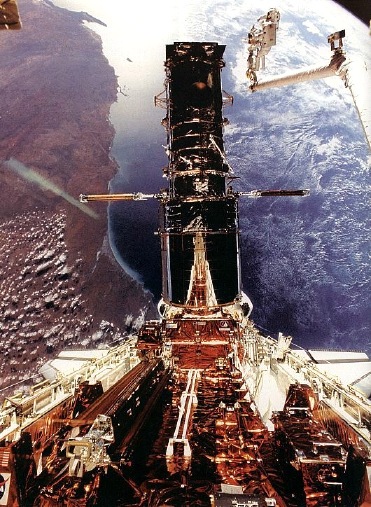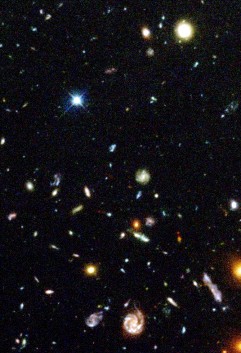|
----------------- a work of fiction Jupiter moons ----------------- to Galileo
|

|
|
|
|
|
||
|
----------------- a work of fiction Jupiter moons ----------------- to Galileo
|

|
|
The solar system extends far past the orbit of Saturn, but for exploring those regions, the many planetary satellites and the universe beyond--for all these (as well as taking pictures, dissecting colors etc.), the human eye needed the help of an optical instrument: the telescope
The story of the telescope and its technology is too big and too rich to be told on this single web page. The most that can be presented here is a short historical summary. For more, I recommend just one book
The telescope was invented in 1608 by Hans Lipperhey, a Dutch lens-grinder. Glass manufacture improved over the centuries, and by 1600 eyeglasses were widely used for correcting vision --not just the convex kind (for far-sighted eyes) but also, in later years, concave ones for near-sighted vision. Lipperhey found that if he combined the two kinds and adjusted the curvature and spacing, the combination could make objects seem a few times closer. The Protestant Dutch were then struggling against the Catholic Spaniards (who once had ruled them, and had not entirely given up), so Lipperhey showed his invention to his duke, suggesting it may help in war. But the Duke bragged about it to the Spanish ambassador, the secret leaked out and Lippershey missed his hoped-for reward. However, Galileo Galilei in Italy heard of the telescope, and not only adapted the new technology to astronomy, but also pushed it to its limits. Instead of a magnification of 3 (as in modern opera glasses, which use the same principle), he used differently curved lens to make objects seem closer 8, 20 and then about 30 times. With his telescope he discovered the crescent shape of Venus and the satellites of Jupiter, both seen as evidence for the theory of Copernicus. Unfortunately, he voiced his support a bit too loudly for the dogmatic church of his time, and in the end was put on trial and found guilty. He also saw the craters of the Moon, and noted that the fuzzy Milky Way stretching around the sky was in fact composed of huge numbers of faint stars. Kepler analyzed the optics mathematically and came up with a design using two convex lenses, though all images were now seen upside down. Astronomers did not mind the inversion--and for use on Earth, an additional lenses re-inverted the image once more. Many discoveries were made with early telescopes (including the existence of sunspots, projected through the telescope on a screen), but they had one big problem. A lens refracts light the way a prism does, and as most people know nowadays, different colors refract by different amounts. Planets and other celestial objects generally shine in a mixture of colors (white is such a mixture), so if a telescope is focused to give a sharp image of (say) green objects, images of white objects (and of most others) appear surrounded by blurry colors. The problem was caught in the wide web of interests of Isaac Newton, who thought it was intrinsic to lens technology. Light can also be focused by curved mirrors, however (like magnifying mirrors in cosmetics sets), and he therefore devised in 1668 a telescope whose light was collected by a curved mirror, made of an alloy with good reflecting quality ("speculum metal"--speculum means mirror, hence the verb "to speculate"). Mirrors need to be figured to greater accuracy than a lens but Newton, ever ingenious, also invented new technology for grinding them, one still used by amateurs, and succeeded where earlier efforts had failed. The reflected converging beams were caught by a small auxiliary mirror and turned 90 degrees into an eyepiece. Such "Newtonian telescopes" are still popular: the fact that the eyepiece is near the top of the instrument, not at the bottom, helps observers, but more important, in spite of the added accuracy requirement, it is generally easier to build big curved mirrors than big lenses (and only one side needed polishing, not two). Newton was premature in giving up on lenses--in 1758 John Dollond patented an "achromatic" ("non-color") combination of a pair of lenses made of different types of glass, which acted like a single lens but cancelled most of the "dispersion" of different colors. Soon afterwards however a new figure appeared on the scene--a German musician transplanted to England, Wilhelm Herschel (later William, still later Sir William), who proceeded to build a series of mirror telescopes bigger and more powerful than any in existence. With one of his new instruments, William discovered in 1781 a new planet, now known as Uranus, a story which will be told separately. To observe faint objects (and also, as turns out, to resolve more detail), a telescope benefits by increasing its aperture--the size (e.g. diameter) of the element first intercepting the star's light, whether a lens or a mirror. For most of the next century, telescopes of speculum metal provided the greatest apertures, though telescopes using achromatic lenses were also in wide use. The biggest metal mirror was built by Earl Rosse in Ireland, and provided the first good image of the Andromeda nebula (which lady Rosse drew--cameras were yet to come). However metal mirrors were heavy, needed periodic repolishing and their reflection reduced brightness. Lens telescopes were lighter and more rigid. In the 20th century, the advantage returned to mirrors made of glass (with silver or aluminum coating) which are lighter, can be supported from the rear and also (see below) may be combined into arrays and slightly flexed.  Then came the accessories--spectrometers to split the light and deduce from its spectrum the composition of stars, and spectroheliographs to observe the Sun in just one color--the source being so bright that an astronomer could get a good image even if most of the light was discarded. Photographic cameras made time-exposures possible--among other things, helping hunt asteroids and allowing time exposures which greatly increased sensitivity for dim objects. Today, electronic light amplifiers (charge-coupled devices or CCDs) do an even better job. For instance, the 11-day time exposure by the Hubble orbiting telescope of the "ultra deep field" recorded some of the most distant faint galaxies. (A detail of one such "deep-field" picture is on the right; practically all the objects are distant galaxies.) Innovative eyepieces and other modifications meanwhile greatly expanded the field of view of telescopes, culminating in the Schmidt telescope of 1930 where a large transparent "correcting plate" was placed at the head of a mirror telescope.
Then came the accessories--spectrometers to split the light and deduce from its spectrum the composition of stars, and spectroheliographs to observe the Sun in just one color--the source being so bright that an astronomer could get a good image even if most of the light was discarded. Photographic cameras made time-exposures possible--among other things, helping hunt asteroids and allowing time exposures which greatly increased sensitivity for dim objects. Today, electronic light amplifiers (charge-coupled devices or CCDs) do an even better job. For instance, the 11-day time exposure by the Hubble orbiting telescope of the "ultra deep field" recorded some of the most distant faint galaxies. (A detail of one such "deep-field" picture is on the right; practically all the objects are distant galaxies.) Innovative eyepieces and other modifications meanwhile greatly expanded the field of view of telescopes, culminating in the Schmidt telescope of 1930 where a large transparent "correcting plate" was placed at the head of a mirror telescope.
Towards the end of the 19th century, the biggest telescopes of both kinds were built in the US through the efforts of the same man--George Ellery Hale. He was responsible in 1897 for the Yerkes Bay refracting telescope--with its 40" lens, still the biggest ever--and for a series of mirror telescopes atop Mt. Wilson and (later) Mt. Palomar in southern California, with a 100" on Mt. Wilson (Edwin Hubble's telescope) and the 200" Mt. Palomar telescope which Hale did not live to see completed. Today's mirrors are made of glass coated with silver or (later) aluminum, lighter and more reflective, and with huge apertures. To eliminate the sagging of mirrors under their own weight, many use multiple mirrors, carefully aligned. Increasing the aperture also improves the "resolution," i.e. shrinks the blur of the image due to the finite wavelength of light. That however, is not enough: resolution is also degraded by atmospheric turbulence--by the slight difference of air refraction caused by local variations of temperature (also the cause of the twinkling of stars in the summertime), enormously magnified in a telescope image. Selecting observatory sites with "good seeing" (and distant from urban lights!) became a big consideration, and ultimately "adaptive optics" overcame the problem of turbulence, shifting and warping the panes of multiple-mirror telescopes by small motors. Orbiting telescopes also avoided that problem, with the additional advantage that wavelengths of light absorbed by the atmosphere--ultra violet etc.--could also be used. Telescopes for infra-red (which needs special detectors) ultimately penetrated obscuring clouds and revealed the vicinity of the center of our galaxy with a resolution of a few hundredths of a second of arc--whereas 100 years earlier, one second (even in regular light) was considered quite good. Even X-ray telescopes were built, operating in orbit, e.g. the large Chandra telescope. X rays tend to penetrate material, not to be reflected, except when they arrive at a very shallow angle. That was achieved by a nest of curved conical mirrors stacked one inside the other. Radio telescopes were another innovation. The classical formula for the resolving power of a telescope involves the ratio between the collecting surface (mirror or lens) and the wavelength used, and that would suggest a very poor resolution for radio telescopes, since radio waves are long. However arrays of antennas may be miles wide and even be continents apart, giving these instruments the best resolution of all. Enough for now. For more, read your books. |
Next Planet: #P-11 Uranus
Next Stop (following "The Planets"): #9c The Discovery of the Solar System, from Copernicus to Galileo
Timeline Glossary Back to the Master List
Author and Curator: Dr. David P. Stern
Mail to Dr.Stern: stargaze("at" symbol)phy6.org .
Last updated:27 February 2008